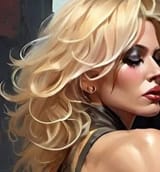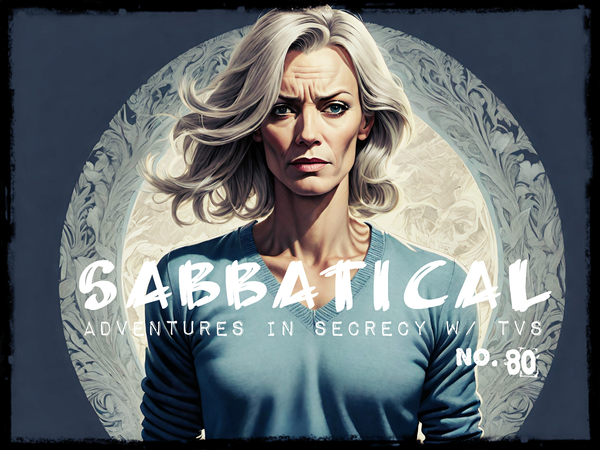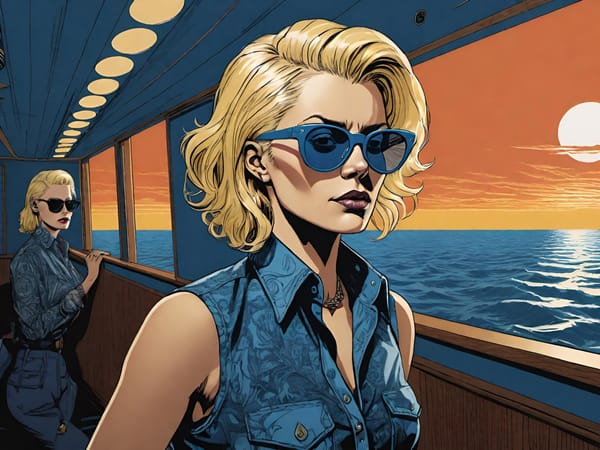Of Living Cities, Destroying Worlds, and Writing About Living Cities and Destroying Worlds
Hey there mah pretties! How are you on this cold winter’s day? Or not, cos weather is super weird and it seems to be radically different all the time. Or you’re in Australia. You know, whatevs.
So apparently trying to catch you up on what I’ve been doing for the last eight years is, you know, challenging. But we’re doing it one newsletter-sized bite at a time! And that pairs well with two of the things I want to tell you about today: the art of metafiction (or my interpretation of that, anyhow) and the Living City of Azza-Jono, which has, as of late, kina been my default world to write in.
Metafiction, TVS style
If we do the thing that makes every professor in the world cringe, and we start with a dictionary definition–which, sidebar, is kina effed, right? I mean, why have dictionaries or words mean things if we’re not going to use them? I know I know, it’s a style thing. But still, y’all, pls–Oxford gives us this:
fiction in which the author self-consciously alludes to the artificiality or literariness of a work by parodying or departing from novelistic conventions (especially naturalism) and traditional narrative techniques.
Recently, folks in TV writing have used ‘meta’ to mean essentially the same thing as “leaning on the fourth wall”.
And That Font of All Knowledge, Wikipedia, says (currently, until some asshole changes it) there are multiple types:
Explicit/implicit metafiction
Explicit metafiction is identifiable through its use of clear metafictional elements on the surface of a text. It comments on its own artificiality and is quotable. Explicit metafiction is described as a mode of telling. An example would be a narrator explaining the process of creating the story they are telling.
Rather than commenting on the text, implicit metafiction foregrounds the medium or its status as an artefact through various, for example disruptive, techniques such as metalepsis. It relies more than other forms of metafiction on the reader's ability to recognize these devices in order to evoke a metafictional reading. Implicit metafiction is described as a mode of showing.
Direct/indirect metafiction
Direct metafiction establishes a reference within the text one is just reading. In contrast to this, indirect metafiction consists in metareferences external to this text, such as reflections on other specific literary works or genres (as in parodies) and general discussions of aesthetic issue. Since there is always a relationship between the text in which indirect metafiction occurs and the referenced external texts or issues, indirect metafiction always impacts the text one is reading, albeit in an indirect way.
Critical/non-critical metafiction
Critical metafiction aims to find the artificiality or fictionality of a text in some critical way, which is frequently done in postmodernist fiction. Non-critical metafiction does not criticize or undermine the artificiality or fictionality of a text and can, for example, be used to "suggest that the story one is reading is authentic".
Generally media-centred/truth- or fiction-centred metafiction
While all metafiction somehow deals with the medial quality of fiction or narrative and is thus generally media-centred, in some cases there is an additional focus on the truthfulness or inventedness (fictionality) of a text, which merits mention as a specific form. The suggestion of a story being authentic (a device frequently used in realistic fiction) would be an example of (non-critical) truth-centred metafiction.
Confused yet? Well, you’re about to be, because none of this is really what I mean when I say it. Sure, there are elements of many of these types present in my work, but when I think of metafiction as a process, it is essentially that the product and the process are more or less the same. (I cribbed that from John Barth.)
I explain this process at length in an untitled book I wrote that I sometimes call the tenth one cos it is the tenth Secret of Secrets novel, as well as a compilation of everything I’d learned about writing up to that point. I intentionally only proofed it, resisting strong urges to improve upon it or developmentally edit it because if I had done so, I would have shattered the lens I crafted. You can judge for yourself how effective I was, but it was important that I be able to show myself and whoever reads it where I was at that time in my life and my growth as an artist.
At the risk of repeating some of that material here (but saving you a trip to Tablo), I’ll tell it again, probably differently, but that’s all right.
You start with where you are, who you are, what you’re doing. So I’m in my office, my home office, I’m T, and I’m writing a newsletter; or, more specifically, I’m typing out a newsletter on my laptop, composing an essay about metafiction and my writing process and adding in hyperlinks.
So, if I weren’t an sf writer, I might just do it like that. Stay with those details. But cos I am, like, a spec-fic nerdess and want to imagine different and more far-out worlds, I can adjust the details like so:
You start with where you are, who you are, and what you’re doing. So I’m in my office on the Homeworld, the Homedub, da Homesquirr. I’m Teresa Van Santana, Master Secretist, eater of those woes and joys that others clutch dear, and I’m etching into holobeams all the words of wisdom I don’t have, dripping honey across the galaxy along those invisible filaments, connecting to the prefrontal cortexes of those unlucky sods who count themselves among my readership.
So that’s a classic Teresa-style version. Say I wanted something new, like a new character, a new world. Let’s look at that:
You start with where you are, who you are, and what you’re doing. I’m in the Quiet Room, a kind of cell, like a monastic cell, not a prison cell, the only place on the ship where I can find solitude and allow my thoughts to drift at the right speed for me to surf them. I’m Garra tel-Lost, insofar as I am myself and not a collection of microbial life and aggregated elements, and I am writing to you, my brothers and sisters and siblings of the Deep, in the sincere hope that we can once again be together, that we can reunify and reunite, and together rise up and liberate ourselves from the burdens of hypermaterialistic oppression.
Now you know how I do it. Feel free to ask questions or leave comments about it. Would love to hear your thoughts. There will be, of course, more in future issues and you can play along and have a hand in what that looks like.
The Living City of Azza-Jono
If you want the short version, you can read that here on Ello. If you want to dive right into the works themselves, here is a portal for that (so a link to a list of links–I know, thanks T).
For those of y’all who want the short short verszh, it goes like this:
Real life: It’s a multidisciplinary open world art project about a city that is alive in some sense, with no set rules, only a short list of initial ideas that contribs are free to adopt, ignore, or change.
My in-world understanding: It’s a female city who is alive but is an urban organism, not a biological one, so Her motives are mysterious to Her denizens–probably beyond mysterious and actually unknowable. But there’re folks who’ve built a religion about worshiping Her and interpreting what they think She wants. It’s divided down the middle by an enormous wall that is basically a natural rock formation, but the rich assholes who rule the City claim they built it and own it. On one side is Azza, which is where most of my stories take place. The other side is Jono, which is bizarre and surreal, fuks dain takks lik-dis and so it can be difficult to make out what they’re saying. Azza’s government is a fascist oligarchy that masquerades as a democracy. Jono is, to the Azzine mindset, pure chaos, just anarchy incarnate. It is, I guess, but there’s just an entirely different mindset, one that doesn’t include the rigidity that Azzines cling to so desperately.
So my friend Ryan has given me some helpful feedback about what it’s like to read these stories. He says they’re confusing at first, and it’s hard to get a feel for what the world is like. Is it fantasy? It seems that way because there’s magic and a city that’s literally alive and things like that. But then there’s also Elton John songs and cars and other things that seem very much grounded in our reality. He says that after reading them in batches (cos many are very very short, like a few hundred words or less), your mind starts to gradually get a sense of the place and who all is there, how they are (or might be) connected. He confirmed that it creates a kind of dreamy sense of the work, which is more or less what I’m aiming to do. Let me know if it does that for you! (Also shout out to Ryan for being my first entirely voluntary subscriber! You da best!)
I’m going to start y’all off with “All You Have to Do Is Dream.” It features a so far unnamed character referred to as the dream thief. In another post, beyond the paywall, I’ll explain who they are, how I came up with them, and what’s the dealyo with their guild and all that. And by the by, I’m not going to hold the writing itself for ransom, okay? You get the commentary because I want to say thank you for supporting me and give you a little extra attention. We’re trying to rise above separateness and monetization and build some kind of community that’s about mutual support and respect. I’m not smart enough to figure that out on my own, but that’s where I’m coming from, just so you know.
Anyway, here’s the story, which is very short, about 100 words:
The dream thief sat on their porch, sulking behind their mask. This wasn’t the first time they’d been ousted and ostracized by the guild for their behavior—acts which they thought were perfectly reasonable. No, it was the guild—or, more specifically the guild mistress, with her insufferable ego, that was the problem. They were a victim, a hapless causality in the Gee Em’s feckless rantings and petty exertions of positional authority. Why wouldn’t the other thieves listen to them? Why did they always side with her?
They stood and kicked the gravel at the base of the steps with their low-top Cons, then went moping on down the alleyway as the riots continued in the thoroughfare.
But T! You also said something last time about destroying world-building!
Huh? Oh yeah, right. Let’s see. What did I mean by that …
I’m being silly. Of course I remember.
World-building generally annoys the shit outta me as a reader. I get it; it’s hard to describe an entire fictional universe (or set of universes) in a few pages, and writers are as a rule terrified of readers getting lost. I’m not, which is probably one of a plethora of reasons why I’m not read by a wider audience. And I generally tend to trash things in my work that annoy me about fiction writing. Sometimes literally, in the text, you know, Teresa will take a shit on world-building. Other times, it’s recessed and comes up in how I approach my own world-building, which, simply put, is to destroy it.
So y’all saw how we can create an entire universe from some simple alterations to a basic set-up. The idea is similar. If I find myself creating pages and pages of world-building documents, I let that shit be there, you know in the documents, but I’m also trying to kind of undermine it wherever I can. To me as a reader, this adds verisimilitude, which is an important part of transporting me into a fictional world where I feel like I’m really there and not just reading. Your mileage may vary; and, in fact, most folks I know say they’re just the opposite: that inconsistency pulls them out. And that’s fine. But for me, life is not fully mapped out, not even partially, really. It’s simply populated by ideas ranging from fluid hypotheses to calcified beliefs, and this creates an artificial certainty of reality. I’m not eager to forget that or to let you forget that.
Examples, examples. Jeez, this one is a little harder to spell out, but lemme try since I brought it up, brought it on myself.
Azza-Jono is a Living City. I capitalize that to suggest that it’s a world-building element. But then I don’t really do anything with it. So it flags it in your mind, then sort of collapses.
Or Teresa Van Santana is a Master Secretist (which I never tell you what a secretist is or really what one even does) and a fiction writer who lives in the Thirty-Second Century (da 32C, yo) which to all appearances is pretty similar to the world we live in, which leads you to think that the whole ‘thirty-second’ thing is schtick and parody of the attention economy and all that. But then there are flying cars. And starting in the second book, magic. These things don’t go together. For most folks, anyhow. It breaks the world. And it’s important for me to do that with some regular frequency. After all, all those things are true now. There is something people call the attention economy. There are flying cars. There are magicians. And we really live in a world like that. So why can’t that exist in fiction? It’s an important question, and I keep trying to give examples in the stories I tell.
Well, that’s it for today. More to come. Stay warm or cool but not both.
Xoxo,
T
AIS 0003





